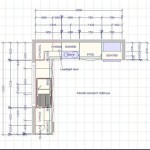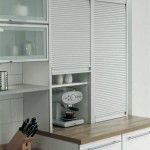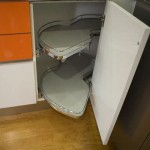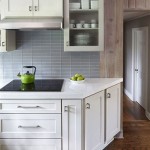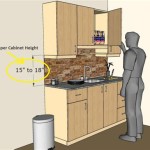Images of Two-Tone Painted Kitchen Cabinets: A Comprehensive Guide
Two-tone kitchen cabinets represent a significant trend in contemporary kitchen design. This design approach involves painting upper and lower cabinets, or different sections of the kitchen, in contrasting colors. The visual interest generated by this technique allows for a customized and sophisticated aesthetic. Examining images of two-tone painted kitchen cabinets provides valuable insight into the diverse possibilities and considerations involved in implementing this design style.
This article will delve into the nuances of two-tone kitchen cabinet designs, exploring various color combinations, hardware choices, and overall design principles. Analyzing visual examples helps to understand how different elements work together to create a cohesive and stylish kitchen space. We will explore the advantages and disadvantages, as well as the practical considerations, to make an informed decision and how they can be used to enhance that space.
Understanding the Appeal of Two-Tone Cabinets
The popularity of two-tone kitchen cabinets stems from their ability to offer several key benefits. First, they introduce a visual dynamism that can elevate a standard kitchen design. Monochromatic kitchens, while often sleek and modern, can sometimes feel flat or lacking in personality. Two-tone cabinets, on the other hand, create a focal point and add depth to the space. The selected colors can also influence the perceived size and light levels of the kitchen. A lighter color on the upper cabinets can brighten the space, while a darker color on the lower cabinets can ground the design and conceal everyday dirt and grime.
Second, this design approach allows for a high degree of personalization. Homeowners can express their individual style preferences through the choice of colors. From bold and contrasting combinations to subtle and harmonious pairings, the possibilities are virtually limitless. It's also a way to integrate existing architectural features or appliances into the overall design scheme. For example, if the kitchen has a strong natural wood element, one color in the two-tone palette can be chosen to complement or contrast it.
Third, two-tone cabinets can visually separate different zones within the kitchen. An island, for example, can be painted a different color than the perimeter cabinets to define it as a distinct workspace or entertainment area. This is particularly useful in open-concept kitchens where the kitchen area blends seamlessly with living and dining spaces. The color variation can subtly delineate the boundaries between these areas.
Examining images of successful two-tone kitchen designs highlights these advantages. The strategic use of color can transform a mundane kitchen into a visually engaging and functional space tailored to the homeowner's needs and aesthetic preferences.
Exploring Color Combinations and Design Styles
One of the most crucial aspects of two-tone kitchen cabinet design is the selection of color combinations. The chosen colors must complement each other and align with the overall style of the kitchen and the home. Numerous combinations are available, each creating a different atmosphere and visual impact.
Classic combinations often involve neutral colors, such as white and gray, or white and navy blue. These pairings create a timeless and sophisticated look that works well in both traditional and modern kitchens. White upper cabinets paired with gray or navy blue lower cabinets create a bright and airy feel while adding a touch of depth and character. These neutral combinations are often paired with stainless steel appliances and either light or dark countertops, depending on how much contrast is desired.
For a more contemporary look, bolder color combinations can be explored. These might include pairing a dark color like charcoal gray or black with a bright accent color like yellow, teal, or emerald green. These striking combinations make a statement and can add a touch of personality to a modern kitchen. Another popular trend is to use different shades of the same color family, such as light gray upper cabinets with dark gray lower cabinets. This creates a subtle and sophisticated monochromatic effect with added depth.
Images often display earth-toned combinations for a warmer and more rustic feel. These might incorporate shades of beige, brown, olive green, or terracotta. Such palettes are particularly well-suited for farmhouse-style kitchens or kitchens that emphasize natural materials. Consider pairing cream-colored upper cabinets with wood-toned lower cabinets to create a natural and welcoming atmosphere.
The design style of the kitchen will also influence the choice of colors. A modern kitchen might benefit from sleek, minimalist cabinets in contrasting colors like black and white. A traditional kitchen might look best with more ornate cabinets in softer, muted tones. Ultimately, the choice of color combinations should reflect the homeowner's personal preferences and the overall aesthetic of the home.
Furthermore, the finish of the paint can also impact the overall look. Matte finishes tend to absorb light and create a softer, more understated look, while glossy finishes reflect light and create a more dramatic and modern feel. Experimenting with different color combinations and paint finishes is crucial to achieve the desired aesthetic.
Practical Considerations and Implementation Tips
While the aesthetic appeal of two-tone kitchen cabinets is undeniable, several practical considerations should be taken into account when implementing this design approach. Proper planning and execution are essential to avoid design flaws and ensure a cohesive and functional kitchen space.
First, the size and layout of the kitchen should be carefully considered. In smaller kitchens, using lighter colors for the upper cabinets and a darker color for the lower cabinets can help to create a sense of spaciousness and prevent the room from feeling cramped. In larger kitchens, bolder color combinations and more dramatic contrasts can be used without overwhelming the space. The layout of the cabinets should also be taken into account. For example, if the kitchen has a large island, painting it a different color than the perimeter cabinets can help to define it as a focal point.
Second, the choice of hardware, countertops, and backsplash should complement the two-tone cabinet design. Hardware should be chosen to match the style of the cabinets and the overall aesthetic of the kitchen. For example, stainless steel hardware is a popular choice for modern kitchens, while brass or bronze hardware might be more suitable for traditional kitchens. Countertops and backsplashes should be chosen to complement the cabinet colors and create a cohesive look. Neutral countertops and backsplashes are often a safe choice, but bolder colors and patterns can also be used to add visual interest.
Third, the painting process itself is crucial to achieving a professional-looking result. Cabinets should be properly prepped before painting, including cleaning, sanding, and priming. High-quality paint should be used to ensure a durable and long-lasting finish. Consider hiring a professional painter to ensure that the cabinets are painted evenly and without any imperfections. A poorly executed paint job can detract from the overall aesthetic of the kitchen and diminish the effectiveness of the two-tone design.
Additionally, take into account the existing elements of the kitchen and how they will work with the new cabinet colors. If there are already stainless steel appliances in the kitchen, incorporating gray or silver tones into the cabinet colors can create a coordinated look. Ultimately, the goal is to create a cohesive and harmonious design that reflects the homeowner's personal style and enhances the functionality of the kitchen.
Images provide a valuable resource for visualizing these practical considerations. Examining examples of kitchens with different layouts, hardware choices, and countertop materials can help homeowners to make informed decisions and avoid common design mistakes. By carefully considering these factors, homeowners can create a two-tone kitchen cabinet design that is both aesthetically pleasing and functionally sound.
Careful planning and attention to detail are essential to ensure a successful outcome. By considering these practical factors, homeowners can create a two-tone kitchen cabinet design that is both visually stunning and functionally sound.

20 Two Toned Kitchen Cabinet Ideas
:strip_icc()/housesprucingtwotone-635e1f1e3437433aa69b091bd16e2e81.jpeg?strip=all)
30 Stylish Two Toned Kitchen Ideas From An Expert

Painting Kitchen Cabinets Are One Way To Freshen Up Your Without The High Cost An Cabinet Design Colors Decor

Can You Paint Kitchen Cabinets Two Colors In A Small The Decorologist

Two Tone Kitchen Cabinets Will Reinsure Your Favorite Spot In The With It S Color Combination New Cabinet Colors

Design Inspiration Tips For Two Tone Kitchen Cabinets Hirshfield S

Choosing The Right Paint Color For Kitchen Cabinets

Two Tone Kitchen Cabinet Ideas For Your New Ugly Duckling House
:strip_icc()/goldalamodetwotoned-7898e45ce4004aec878721b187b98301.jpeg?strip=all)
30 Stylish Two Toned Kitchen Ideas From An Expert

10 Two Tone Kitchen Cabinet Ideas 2024 Mix And Match Cabinets Gray White Makeover

